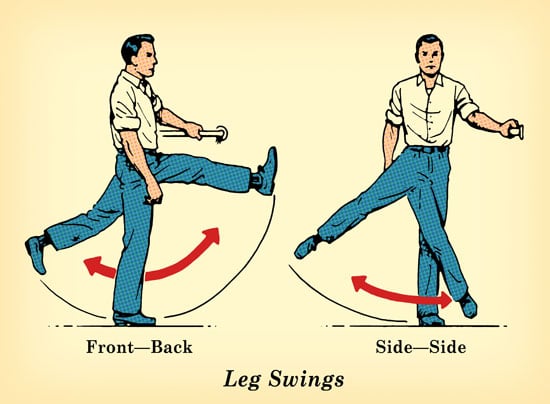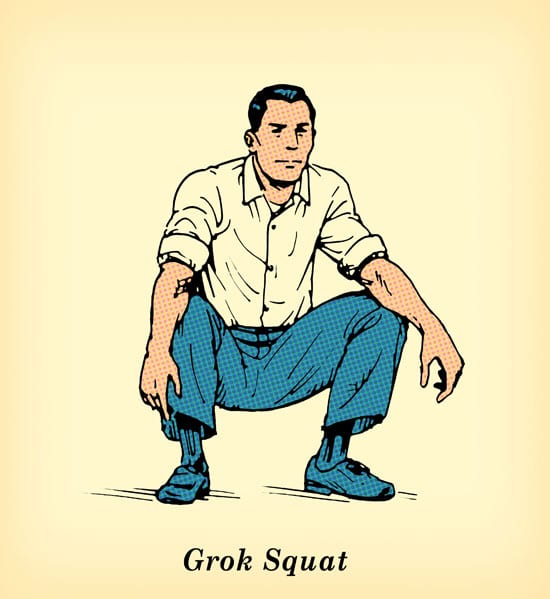If you’re like most men living and working in a techno-service economy, you probably spend a good deal of your day sitting down. You go from the kitchen table to your desk at work to your chair in front of the TV. But as we’ve discussed before, spending most of your waking hours planted on your keister is terrible for your health.
You’ve probably experienced those moments when you get up from a sitting position and your butt feels numb and your hips feel so tight that you have to lean forward at the waist just to walk. Excessive sitting leaves your hips and legs tight and your glutes inactive. Even after you stand up, the ill effects of sitting stay with you and may prevent your butt muscles from firing at an optimal level when you really need them – like when you suddenly need to chase down a purse snatcher![amazon asin=B00JREVI5G&template=*lrc ad (right)]
Some fitness experts argue that sitting causes muscles in the hip area to physically shorten (and stay shorter), even after you stand up. While there are no scientific studies to back that claim, from my own personal experience, sitting for lengthy periods of time definitely makes everything feel tight in the groin/butt area.
If you’re an athlete (or fancy yourself one), tight hips and inactive glutes can hamper physical performance in a variety of activities, such as sprinting, squatting, and — my favorite — deadlifting. If you want to perform at your best, you need to make sure that your hips stay limber and that your butt muscles are firing on all cylinders. Even if you’re not interested in deadlifting 600 lbs. (though I hope to change your mind on that someday), keeping your hip flexors loose and glutes active can improve your life on other fronts.
First, having limber hips just feels good, plain and simple. Second, having a healthy range of motion in your hips can help prevent injury when you pursue more recreational physical activities and do household chores. For example, loose hips keep your IT band loose as well, which can ward off knee pain. Finally, taking care of your hips may help improve your posture, which can in turn alleviate back or neck pain. (Not to mention the role of limber hips in doing a mean mambo.)
Below, we provide some simple stretches and exercises that will undo the damage to your hips and butt caused by sitting.
Prevention Is the Best Remedy: Sit Less and Move More[amazon asin=B002IYRBI0&template=*lrc ad (right)]
As the saying goes, “an ounce of prevention is worth a pound of cure.” The best thing you can do for your hip mobility and glute activation is to simply sit less and move more during the day.
If your employer will allow it, try using a standing desk, which keeps your muscles activated at the office. Keep in mind that, just as with sitting, standing should be done in moderation (doing it for an extended period of time isn’t that great for you, either).
If a standing desk isn’t an option, take five-minute breaks from sitting every 30 to 45 minutes. Stand up and walk around a bit. Maybe even perform a few of the exercises below. Even if you have a standing desk, you should still take breaks every now and then for some movement.
Stretch Out Those Hips
These dynamic stretches and exercises are designed for loosening tight hips that come from sitting too much. I try to incorporate a few of them in my daily workout warm-ups or even sneak some in when I’m hanging out with the kids (who think their dad is pretty odd). Every now and then I also dedicate an hour on Saturdays to just hip and glute work, along with some intense foam rolling.
If you’re really tight, take it nice and easy. As physical therapist Kelly Starrett says, “Don’t go into the pain cave. Your animal totem won’t be there to help you.”
Leg Swings
 [amazon asin=B000VICRO8&template=*lrc ad (right)]This is a great dynamic stretch that I do before every workout. It loosens up the hips, hamstrings, and glutes.
[amazon asin=B000VICRO8&template=*lrc ad (right)]This is a great dynamic stretch that I do before every workout. It loosens up the hips, hamstrings, and glutes.
Begin with forward leg swings. Find something to hold for balance. Start off swinging your right leg backwards and forwards as high and as far back as you comfortably can. Do 20 swings and then switch legs.
Next are side-to-side swings. Again, find something to hold for balance. Swing your right leg out to the side as high as possible and then in front of you towards your left as far as you can go. Perform 20 swings and then switch legs. Depending on how tight you feel, you may need another set.
Grok Squat
 The Grok Squat is very similar to a catcher’s stance in baseball. Simply squat down until your butt touches your ankles. Keep your heels firmly on the ground and your back straight. Hold that position for 30-60 seconds. You should feel your hamstrings, quads, Achilles tendons, lower back, and groin gently stretching. If you’re super stiff, it may take a few days of practice to sink into a full squat. Keep at it. Your back and hips will thank you.
The Grok Squat is very similar to a catcher’s stance in baseball. Simply squat down until your butt touches your ankles. Keep your heels firmly on the ground and your back straight. Hold that position for 30-60 seconds. You should feel your hamstrings, quads, Achilles tendons, lower back, and groin gently stretching. If you’re super stiff, it may take a few days of practice to sink into a full squat. Keep at it. Your back and hips will thank you.
Intersperse a few short squatting sessions into your daily routine.



